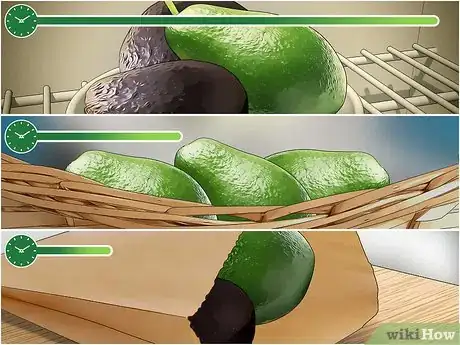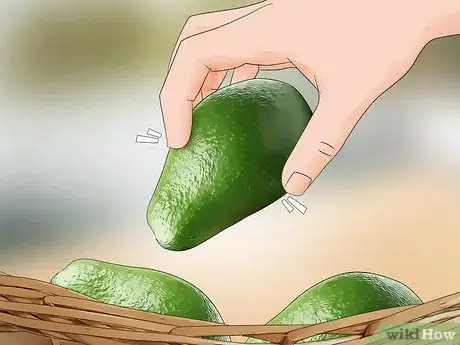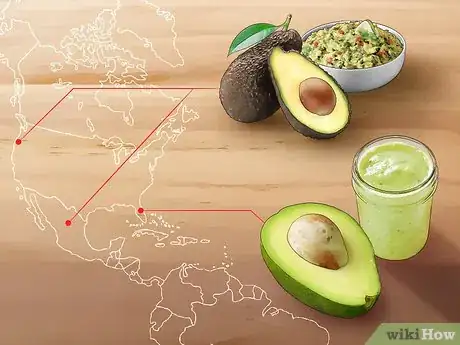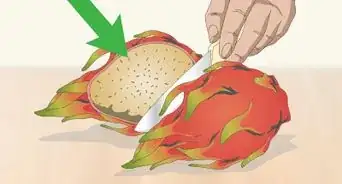This article was co-authored by Jennifer Levasseur. Chef Jennifer Levasseur is a Personal Chef and the Owner of The Happy Cuisiniere based in Breckenridge, Colorado. She has over 12 years of culinary experience and specializes in Mountain and Contemporary Rustic cuisine. Moreover, she can craft dishes and modify menus to accommodate dietary restrictions, such as gluten-free, vegetarian, vegan, pescatarian, and dairy-free diets. In addition to a Bachelor’s degree in Marketing and Management from the University of Houston, Chef Jennifer holds Associate’s degrees in Culinary Arts and Baking & Pastry Arts from Houston Community College.
There are 7 references cited in this article, which can be found at the bottom of the page.
wikiHow marks an article as reader-approved once it receives enough positive feedback. In this case, several readers have written to tell us that this article was helpful to them, earning it our reader-approved status.
This article has been viewed 198,145 times.
An avocado is a tropical fruit with a unique flavor and texture. Avocados can be used for various purposes, such as for making guacamole or homemade beauty treatments, or can simply be enjoyed and eaten on their own. Choosing the correct avocados for your purposes involves first deciding what you will be using them for, then selecting the appropriate type and level of ripeness.
Steps
Choosing Based on Timing and Use
-
1Choose ripe Hass avocados if you’re making guacamole. Hass avocados are available year-round, and make up the vast majority of the avocado market. Their buttery texture is perfect for making great guacamole. Their tough skin allows you to easily dice the flesh while it’s still within the skin, then scoop it out to mix with other ingredients.[1]
- Because it’s tough and flexible, you can also use Hass avocado skin as a creative way to scoop guacamole when you’re serving it to your guests.
- If you’re slicing avocados for a salad or to eat on their own, go with a slightly less ripe fruit than you would for guacamole.
- The slices will stay intact better if they’re a little less ripe, allowing for better presentation.
-
2Determine when you are serving the avocados. If you are preparing a meal containing avocados and need them immediately, choose ripe, ready-to-eat avocados. However, if you are buying the avocados in advance, you can purchase unripe fruit and let them soften at home.
- To ripen avocados at home, you can store them at room temperature, and they should ripen over three or four days, depending on how firm they were when you purchased them.
- To speed up the ripening process, place the avocados in a brown paper bag with a banana. The banana releases small amounts of ethylene gas, which helps other fruit ripen faster.[2]
- To keep the avocados fresh, store them in the refrigerator.
Advertisement -
3Choose an oily variety if you’re making moisturizer or a beauty mask. Avocados are often used as natural moisturizers. The oils in their flesh are what makes them desirable for use on skin. California-grown avocados tend to contain more oil, so take note of its origin when you’re looking for a fruit for beauty purposes.[3]
- Hass avocados are most readily available, and are certainly oily enough for use in beauty masks.
- Other suitable varieties include the Pinkerton, Sharwil, Anaheim, the Daily 11, and MacArthur.[4]
Testing Ripeness and Quality
-
1Test ripeness by feeling how firm the avocados are. Hold the avocado in the palm of your hand. Gently squeeze the avocado, being careful not to press with your fingertips, as this can cause bruising. A ripe avocado will be soft and will yield to the gentle pressure, but will not be overly squishy.[5]
- If it is still hard, then it is still under ripe and will take a few days to ripen.
- Avoid avocados which are overly soft and mushy, since this would mean that the fruit is too ripe.
- Make sure to test out the entire fruit, and don’t judge ripeness by feeling the top of the avocado closest to the stem. This is the first part of the fruit to ripen, so it might be slightly softer while the rest of it is too firm.
- Keep in mind you may still opt to purchase firmer avocados if you’re purchasing them a few days before their intended use. If you want to use your avocados right away, choose the ripest ones you can find.
-
2Check under the stem. If the stem is still attached, give it a pull. If there’s any resistance, the fruit is not yet ripe. If comes off easily, and the area where it was is bright green, it’s perfectly ripe. If it’s yellow-green, it could use a day or so before being eaten. If the area where the stem was is brown or dark green, the avocado is overripe.[6]
- Checking under the stem is one of the quickest and most reliable tricks for determining ripeness, and it removes the risk of damaging fruit by poking and prodding with fingertips.
-
3Check for color and blemishes. Hass avocados, which are the type you’re most likely to encounter at the grocery store, are green when unripe and dark green to near black when ripe. However, make sure you double check any signage posted at the market for the type of fruit and where it was grown. Most Florida avocados, unlike Hass, have lighter-green skin with yellowish tone, even when they are ripe.[7]
- Avocados that are shiny are not yet ripe enough, but again, you can still purchase these and ripen them at home.
- Choose avocados with unblemished skin. Avoid fruit with dark blemishes, brown spots, dents, and bruises.
Choosing Among Avocado Varieties
-
1Buy avocados based on your flavor preferences. Once you begin to master how to choose ripe, good quality fruit, you may develop preferences for specific flavors and textures. Learn which varieties are nuttier or lighter in flavor.
- Purchase the Hass, Lamb Hass, Gwen, Reed, or Sharwil varieties if you prefer avocados with a nutty taste.
- Choose the Bacon and Zutano varieties for avocados that are lighter in flavor.
-
2Learn more about water and oil content. Florida varieties typically contain more water, while those grown in California and Mexico are oilier. These fattier, more oily types are best for guacamole because of their rich texture. You’d also use an oily variety for skin moisturizers, while watery types are great for use in juices. These juicy types tend to have light, sweet flavors, and weigh up to five pounds.
- Watery varieties include the Choquette and Hall.[8]
- In addition to oilier varieties, types with thicker skins, such as Hass and Gwen, are also great for beauty use. Gently rub the peel or skin against your face in soft, circular motions, then rinse with warm water.[9]
- While an avocado's size doesn't directly relate to its quality, it can help you determine where the fruit comes from and whether it has a higher water or oil content.
- Larger avocados, some weighing up to five pounds, are typically from Florida and grow so large because of their high water content. Smaller avocados, with lower water content, are generally from California or Mexico.
-
3Choose avocados that are best for your diet. With evidence that avocados can lower cholesterol and decrease risks for certain cancers, more people are consuming avocados regularly or even daily. If you plan on consuming a large quality of avocados or eating an avocado a day, it might be best to consider choosing varieties that are less rich. Even though two-thirds of the fat an avocado contains is mono-unsaturated and considered healthy, they are still a fatty and high calorie fruit.[10]
- Tonnage avocados are a great balance, as they have a rich texture but much lower fat content than most avocado varieties.[11]
- While it’s the one you’re most likely to come across at the market, Hass avocados are among the fattiest varieties. Its relatives, like the Daily 11, are similarly oily and fatty.
- Consider Florida-grown fruit for lower calorie, lower fat options.
Expert Q&A
-
QuestionHow can I quickly ripen an avocado?
 Jennifer LevasseurChef Jennifer Levasseur is a Personal Chef and the Owner of The Happy Cuisiniere based in Breckenridge, Colorado. She has over 12 years of culinary experience and specializes in Mountain and Contemporary Rustic cuisine. Moreover, she can craft dishes and modify menus to accommodate dietary restrictions, such as gluten-free, vegetarian, vegan, pescatarian, and dairy-free diets. In addition to a Bachelor’s degree in Marketing and Management from the University of Houston, Chef Jennifer holds Associate’s degrees in Culinary Arts and Baking & Pastry Arts from Houston Community College.
Jennifer LevasseurChef Jennifer Levasseur is a Personal Chef and the Owner of The Happy Cuisiniere based in Breckenridge, Colorado. She has over 12 years of culinary experience and specializes in Mountain and Contemporary Rustic cuisine. Moreover, she can craft dishes and modify menus to accommodate dietary restrictions, such as gluten-free, vegetarian, vegan, pescatarian, and dairy-free diets. In addition to a Bachelor’s degree in Marketing and Management from the University of Houston, Chef Jennifer holds Associate’s degrees in Culinary Arts and Baking & Pastry Arts from Houston Community College.
Personal Chef Put an avocado in your freezer and let it harden. Then, immediately thaw your avocado to soften it.
Put an avocado in your freezer and let it harden. Then, immediately thaw your avocado to soften it. -
QuestionHow should I season an avocado if I want to eat it without cooking it?
 Community AnswerI would recommend sprinkling the avocado with some lemon juice, salt, and pepper.
Community AnswerI would recommend sprinkling the avocado with some lemon juice, salt, and pepper. -
QuestionShould you cut them open if you don't use right away?
 Community AnswerIf your avocado is ripe but you don't intend to use it that day, store it in the refrigerator to stop the ripening process. If you've already cut into it, or used half of it, squeeze of bit of citrus juice over the half you're storing. Then wrap it in plastic, and store it in the fridge.
Community AnswerIf your avocado is ripe but you don't intend to use it that day, store it in the refrigerator to stop the ripening process. If you've already cut into it, or used half of it, squeeze of bit of citrus juice over the half you're storing. Then wrap it in plastic, and store it in the fridge.
References
- ↑ http://www.foodrepublic.com/2012/10/18/know-your-avocado-varieties-and-when-theyre-in-season/
- ↑ https://www.avoseedo.com/top-tips-on-selecting-and-storing-avocados/
- ↑ http://superfoodprofiles.com/how-to-apply-avocado-oil-face-moisturizer
- ↑ http://www.foodrepublic.com/2012/10/18/know-your-avocado-varieties-and-when-theyre-in-season/
- ↑ https://www.avocadocentral.com/how-to/how-to-pick-how-to-buy-avocados
- ↑ https://www.avoseedo.com/top-tips-on-selecting-and-storing-avocados
- ↑ http://www.foodrepublic.com/2012/10/18/know-your-avocado-varieties-and-when-theyre-in-season/
- ↑ http://www.foodrepublic.com/2012/10/18/know-your-avocado-varieties-and-when-theyre-in-season/
- ↑ http://www.realsimple.com/beauty-fashion/hair/hair-care/homemade-beauty-products/avocado-moisturizer
About This Article
To choose an avocado, hold it in your hand and gently squeeze. If you plan to use the avocado right away, choose one which feels soft and yields to the pressure of your palm. However, if it feels squishy, it’s probably too ripe and you should pick another one. A ripe avocado should be bright green where the stem was, and it will usually have dark green or black skin, although some varieties stay bright green even when they’re fully ripe. If you’re buying the avocado in advance, choose one which feels firm when you squeeze it and let it ripen at home. If you want to learn which variety of avocado you should choose, keep reading!































































